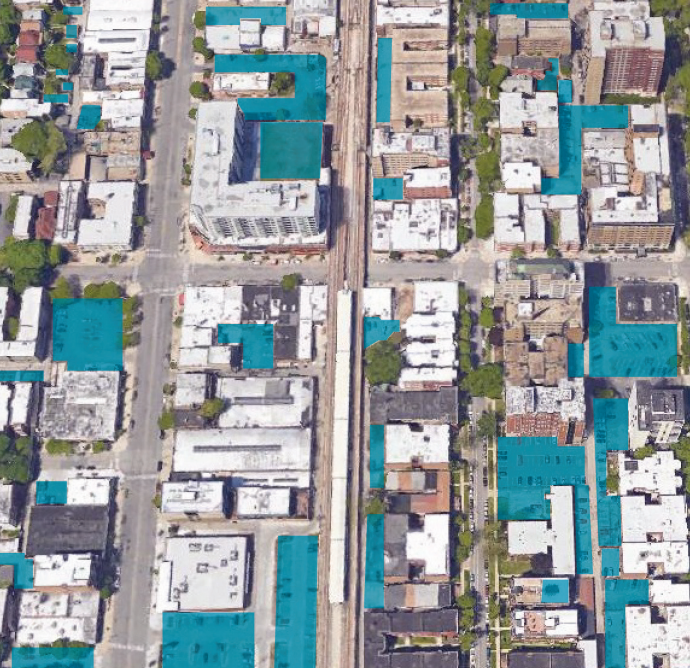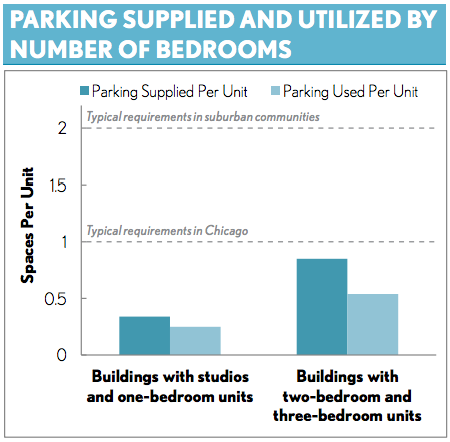There’s not enough parking in Chicago: it’s an article of faith among many drivers, and has been a key assumption in many of the city’s planning efforts. But a new report from the Chicago-based Center for Neighborhood Technology finds that one of those efforts, mandatory off-street parking requirements for residential buildings, is causing an over-supply of parking, with serious consequences for affordability and transportation.

Repeating a methodology used by CNT in Seattle’s King County, Washington, San Francisco, and Washington, DC, researchers went into parking garages attached to residential buildings in the middle of the night, when most people should be home and parking use should be highest. (Full disclosure: I interned for CNT last year, and contributed to the literature review for the report.) They found that, on average, only half the required parking spots in the typical building were actually occupied. Overall, zoning required two parking places per three units, but the survey revealed there was just one parking spot in use for every three units; the city’s zoning law requires one spot per unit for most new buildings.
This oversupply varied by the kind of units and location of the building. Expectedly, units near rapid transit stations used fewer parking spaces—though, crucially, the same was true of units near high-quality bus service, as defined by average frequencies of no more than 15 minutes. Perhaps less expectedly, buildings with larger, family-sized units actually had a greater oversupply of parking than buildings with studios and one-bedroom units. The family-sized buildings used an average of 0.54 parking spaces per unit—but supplied 0.85 spaces.

While 0.31 empty parking spaces per unit may not sound like a big deal, it is. One reason is simply cost: each stall in a parking garage can cost up to $37,000 to build. Even surface parking spaces can cost up to $4,200—and require extra land, or impose significant opportunity costs by reducing the number of housing units than can fit on a parcel. That’s a problem for market-rate developments, where parking has been found to add 10 percent to prices in San Francisco.
But it can be an even bigger burden for affordable housing developers, who need to delicately balance different funding sources to make up the gap between the cost of building and the below-market prices they charge. The tens of thousands of additional financing dollars per unit that parking requirements can impose can kill or drastically scale back a project. That’s all the more ironic, since low-income residents are even less likely to own a car. In fact, even in market-rate developments, forcing every tenant to effectively pay for the construction and maintenance of off-street parking requires people who don’t own cars—who are disproportionately low-income, the elderly, and people with disabilities—to subsidize those who do.
But the presence of off-street parking also affects behavior. As we’ve written before, getting the price right matters when it comes to transportation; by making everyone pay up front for off-street parking whether they use it or not, parking requirements makes the effective difference in cost between parking and not parking a car at your home zero. As a result, more people own cars than would if paying was actually connected to use. In fact, residents of neighborhoods with parking minimums are 28 percent more likely to drive to work, imposing costs in terms of congestion, public safety, and carbon emissions on the rest of society.
The report closes with a “policy toolkit” for municipalities to reform their parking requirements. They include simple fixes, like just lowering the requirements, or even establishing parking maximums—but also other approaches, like shared parking districts that allow different uses with different peak times to share the same parking supply, or credits for carshare spaces, transit accessibility, or other factors that are likely to reduce the need for parking. Anyone looking for a blueprint to reform their city’s parking policies to improve affordability and accessible transit ought to take a look.
